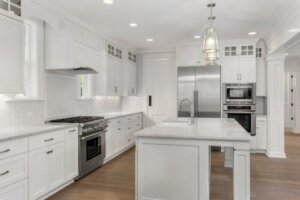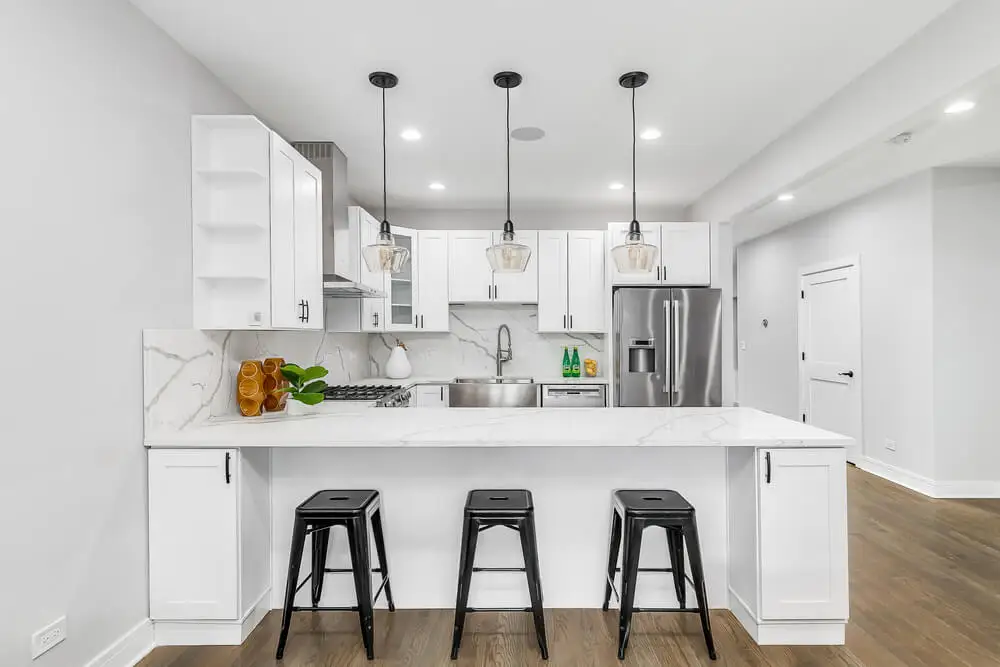Is it a Good Idea to Paint the Kitchen White?

Painting the kitchen white has many great advantages. The tone is associated with an essence of clarity in the area, with the feeling of expansion of the room, and with the serenity you’re looking for in a room that sometimes becomes busy.
White works as a tool adaptable to any decorative style, but there are those who consider it to be a tone that’s conducive to displaying stains and other dirt. The choice of color for the kitchen responds to the tastes of each person, so it helps to look closely at the benefits and drawbacks of such an attractive pigment.
The importance of color in the kitchen area
The book Color Psychology refers to the relationship between colors and feelings. The text asserts that each color produces different and sometimes contradictory effects on people.
Based on this theory, when selecting shades for the kitchen, it’s advisable to be guided by palettes that make you feel comfortable and invite you to enjoy a warm and confident atmosphere. Since this is a busy spot in the house, it always attracts a lot of attention.
Depending on the color range you choose, you give a certain personality to the area. This means that the colors of this room can place you in cheerful, dynamic, sad, or serious spaces.

Reasons to paint the kitchen white
An analysis of the Vic School of Art gives positive readings to white, linked to cleanliness, purity, peace, and virtue. For its part, the creative software company Adobe ® argues that some consider white as a color because white light comprises all the shades of the visible spectrum.
However, they clarify that white is not a color, but a tone that enhances colors. Therefore, white can help awaken the feelings that these colors inspire in us.
This premise is applicable even in the decoration of the dining room. White rooms never go out of style, and it’s very easy to integrate different accessories into them.
Here are some other reasons to paint your kitchen white.
You will have a canvas in your favor
White is not a limiting tone, but instead opens the possibilities to decorate to your heart’s content. You can adapt this base to classic, modern, rustic, or any other idea you have in mind.
An additional advantage of white walls is that if you don’t have a preference for any style, you can simply leave the canvas free, and it’s still impressive.
It gives a sense of greater spaciousness
Especially for small kitchens, white paint is a perfect choice because it offers the feeling of spaciousness. Although they’re not real changes in size, they look more spacious so that your presence in them feels like less of a burden.
Better lighting
Being the most luminous pigment of the color palette, white is able to reflect light up to 96%. In kitchens with little natural light, white is ideal for gaining clarity. In addition, if the floor is the same tone, it reflects the lights of the ceiling lamps, furniture, and the rest of the details.
We think you may also enjoy reading this article: 6 Common Mistakes to Avoid when Decorating the Kitchen
Elegance
Cooking rooms in white tones, apart from modern, are distinguished by elegance. If you want additional colors, there will be no problem merging them. You can add them both to furniture, utensils, and appliances.
Some alternatives to combine with white are the following:
- Black adds more sophistication
- Yellow brings joy
- Red is great for a more passionate room
- Blue also conveys tranquility
A timeless look
Even if there are thousands of trends coming, white kitchens will always be in style. With minimal changes of accessories, you can renew it without changing the paint. The sobriety of white combines with almost any furniture in the rest of the room.
Order and neatness
White paint helps the kitchen look tidy. As long as you keep up with the constant cleanliness, white contributes to a cleaner image of the environment where you prepare your meals.

What are the disadvantages of painting the kitchen white?
Some people consider white kitchens to be cold spaces. For the atmosphere to be cozy, they prefer the walls to be white, but the countertops and furniture to correspond to another palette of the chromatic circle.
They are also likely to believe that white makes a kitchen look like a boring area. However, this is an issue that can be solved by adding plants, textiles, and other decorative materials.
Also, if you weigh the benefits of a white-painted kitchen, the biggest counterbalance is the fact that this color can get dirty very easily. When choosing this shade for your dining area, daily commitment to cleanliness is non-negotiable.
Like this article? You may also like to read: How to Organize Your Kitchen According to Marie Kondo
Paint the kitchen in white or another shade: What should you choose?
White, red, black, or any other shade… the paint you will apply in your kitchen is a personal decision. That’s why it’s important to evaluate the advantages and disadvantages of this option without losing your goal of having a cozy space at home.
Consider aspects such as the general decoration, the size of the room, and the lighting. Above all, decide based on your tastes. If white is the tone of your dream kitchen, then give this tone to one of the most attractive rooms in the house!
All cited sources were thoroughly reviewed by our team to ensure their quality, reliability, currency, and validity. The bibliography of this article was considered reliable and of academic or scientific accuracy.
- Heller E. Psicología del Color. Cómo actúan los colores en los sentimientos y la razón. España. https://dialnet.unirioja.es/servlet/libro?codigo=254510
- La psicología del color blanco y negro. Adobe. https://www.adobe.com/la/creativecloud/design/discover/is-black-a-color.html
- Psicología del color. Escuela de Arte de Vic. España. https://perio.unlp.edu.ar/catedras/iddi/wp-content/uploads/sites/125/2020/04/Psicologia-del-color.pdf
This text is provided for informational purposes only and does not replace consultation with a professional. If in doubt, consult your specialist.








